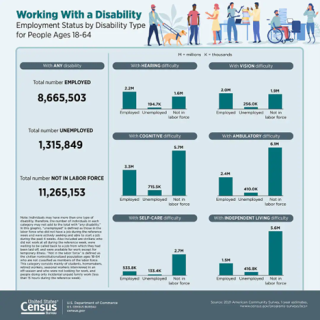Glacier on the Job and in the Air: My Experiences Living and Working with a Service Animal
I’ve had my service dog, Glacier, for more than four years, and while incorporating a service dog into my daily life has been tricky, it’s also been life changing! Having another living being next to me almost 24/7 has required me to adjust my routine in ways that I hadn’t previously considered. Going to work, navigating the office (not to mention transportation to and from the office), making sure Glacier’s “workspace” is comfortable enough to accommodate a full workday, and explaining her presence to curious coworkers are all things I had to consider before I even walked through the door.
Once I started working, I had to navigate a host of seemingly little things to make sure Glacier was well integrated into my day to day -- like picking the spot in the conference room where nobody will accidentally roll over her tail, but that is also close enough to the door to make a hasty exit if she signals she needs a potty break ahead of schedule. It’s a lot!
Service Animal Training and Adventures
Using hiring authorities such as Schedule A and providing reasonable accommodations allows more persons with disabilities to gain employment and stay employed. It also fosters a more diverse, equitable, inclusive, and accessible workplace.
Luckily, working with the experienced and thoughtful reasonable accommodations team at EPA and my Local Reasonable Accommodations Coordinator before I brought Glacier to the office the first time made our adjustment go very smoothly.
Along with my supervisors, we were able to come up with some thoughtful adjustments that made me feel comfortable bringing my service dog to the office — and even take the occasional work trip with Glacier in tow. With 10 flights under her belt, Glacier has become a pro at airports!
In fact, service dogs like Glacier receive extensive training (hers lasted more than a year!) that helps service dogs through all facets of their humans’ lives. The organization that trained Glacier estimates they invest approximately $30,000 to $50,000 into each service dog by the time they are ready to graduate! These dogs can serve a wide variety of roles such as assisting with bracing/balance, mobility, seizure alert, glucose level alert, PTSD support, or autism support.
Believe it or not, there is no license or certificate that people are required to show to prove their dog is trained. This has resulted in many untrained dogs in places they should not be. This can create skepticism among business owners and the general public, which can result in confrontations and denials of entry for the individual who is already dealing with a life-altering disability that is aided through the use of a trained service animal.
Interestingly, miniature horses are the only other animal that can qualify to be a legal service animal. While it may seem odd, mini horses are wonderful for those who need more balance support than a dog can provide, and they live longer than service dogs. Training miniature horses can be a smarter long-term investment for those who don’t have the time or finances to go through the training process every six to eight years, which is average for training a service dog. Flying with miniature horses, however, is a whole other story.
More About Reasonable Accommodations

According to the Bureau of Labor Statistics, the labor force participation rate for persons with a disability is almost 50% lower than the rate for persons without a disability. Using hiring authorities such as Schedule A and providing reasonable accommodations allows more persons with disabilities to gain employment and stay employed. It also fosters a more diverse, equitable, inclusive, and accessible workplace. A reasonable accommodation “is any change in the work environment or in the way a job is performed that enables a person with a disability to enjoy equal employment opportunities.”
It might seem intimidating, and there are certainly barriers to overcome when having a service animal, but the EPA and the Superfund communities that I serve as a Community Involvement Coordinator have been very supportive and welcoming. This allows me – and Glacier – to continue doing the work we love. To learn more about the contributions of America’s workers with disabilities past and present and how inclusive employment policies and practices benefit employers and employees, visit National Disability Employment Awareness Month.

About the Author
Missy Haniewicz
Community Involvement Coordinator
EPA Region 8
Missy Haniewicz is a Community Involvement Coordinator in EPA Region 8. Prior to federal service, she worked in communications and fundraising for regional and international environmental and social justice organizations. She has a BA in International Affairs from the University of Nebraska and a Master of Public Administration from Baruch College at the City University of New York. She also served as a medic in both the Nebraska and New York Army National Guard.
Editor’s Note: The views expressed here are intended to explain EPA policy. They do not change anyone’s rights or obligations. You may share this article. However, please do not change the title or the content, or remove EPA’s identity as the author. If you do make substantive changes, please do not attribute the edited title or content to EPA or the author.
EPA’s official web site is www.epa.gov. Some links on this page may redirect users from the EPA website to specific content on a non-EPA, third-party site. In doing so, EPA is directing you only to the specific content referenced at the time of publication, not to any other content that may appear on the same webpage or elsewhere on the third-party site, or be added at a later date.
EPA is providing this link for informational purposes only. EPA cannot attest to the accuracy of non-EPA information provided by any third-party sites or any other linked site. EPA does not endorse any non-government websites, companies, internet applications or any policies or information expressed therein.
